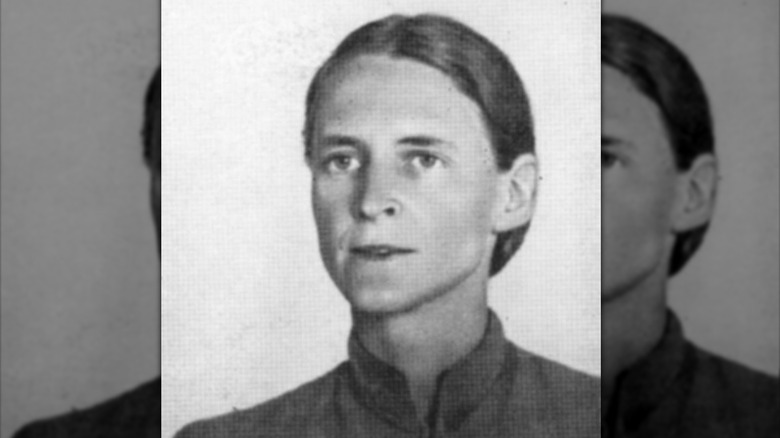Why An American Teacher Was Beheaded Per Hitler's Request
Hitler: the reason that no child since World War II has been named "Adolf." We need not recount Adolf Hitler's sundry crimes against humanity here, or his very uninspired paintings from his university days. Not only did he fail at conquering the world, but he failed to get into art school in Austria. And while we do not doubt that he might have considered himself an unappreciated genius artist, he might have developed a grudge against teachers. And we mean all teachers, in general.
Enter Mildred Fish-Harnack, an American-born, German-speaking English literature teacher who dreamed of being an author. As All That's Interesting recounts, Harnack met her future husband, German-born lawyer Arvid Harnack while teaching at the University of Wisconsin-Madison in 1926. They met in a serendipitous hallway encounter befitting a romcom, got along very well, got married, and Harnack moved to Germany to start her doctorate at the University of Berlin in 1931 while teaching American literature. That is, until she learned that she wasn't "Nazi enough."
Adolf Hitler had come to power during Germany's short-lived Weimar Republic (1918 to 1933), constructed in the aftermath of World War I as a way to reform the country. Demoralized German people wanted a reason to believe in Germany again, and the National Socialist German Workers' — Nazi — Party stepped into the gap. For Fish-Harnack, who made the rare move at that time of hyphenating her married name, her arrival in Germany was just a matter of bad timing. But before her death, she worked as spy undermining Nazi efforts in Germany.
Working with an anti-Nazi network
To be clear, Adolf Hitler didn't direct a dictatorial finger across the Atlantic Ocean toward a random teacher on U.S. soil and demand her assassination. Rather, Mildred Fish-Harnack had the terrible fortune of being on German soil when Hitler came to power. As the story goes, she was fired from her teaching job at the University of Berlin after only about a year and a half, and upon leaving she got involved in an underground, anti-Nazi resistance movement called the "Red Orchestra," per The New York Times. Eventually, the Gestapo discovered a Red Orchestra radio transmission, which led to Fish-Harnack's arrest and eventually execution. As the University of Wisconsin-Madison says, Fish-Harnack was the only American citizen executed on orders from Hitler himself — at least indirectly.
Some sites like How Stuff Works overstate the case and portray Fish-Harnack as a comic book-like action figure, stating that she "led a German resistance that enraged Hitler." The German site Gedenkstätte Deutscher Widerstand states things more realistically. After Fish-Harnack got kicked out of the University of Berlin she took up teaching night classes in the city. Some of her students were politically minded, and she passed along democratically-leaning documents like speeches from U.S. President Roosevelt through her dissident network. Both Fish-Harnack and her husband Arvid did this until she completed her doctorate in 1941, the year World War II started. She and Arvid got arrested the next year.
[Featured image by И.М. Бондаренко via Wikimedia Commons | Cropped and scaled]
Death by beheading
As the CBC explains, much of what we know about Mildred Fish-Harnack comes to us from her great-great niece, Rebecca Donner, who wrote the 2021 book, "All the Frequent Troubles of Our Days: The True Story of the Woman at the Heart of the German Resistance to Hitler." The CBC says that the book took form way back when Donner was 9 years old and started learning a bit about her family history, beginning with a series of height markings against the wall of her great-grandmother's house — one of which belonged to Fish-Harnack. Bit by bit, Donner learned about her great-great-aunt and her time in World War II Germany.
On History Net, Donner tells a complex story resulting in the Harnacks entering German court in December 1942 along with 10 others. Luftwaffe Commander Hermann Göring, aka, "The Bloodhound," wanted to charge them with conspiring with a Soviet spy network. This was true, even though Fish-Harnack didn't know the extent of the network, which was run by the Soviet NKVD, the People's Commissariat for Internal Affairs. After a four-day trial, Fish-Harnack was sentenced to six years at a labor camp but her husband was condemned to death and was executed in December 1942. Adolf Hitler, however, directly countermanded the ruling and ordered another trial for Fish-Harnack. As Gedenkstätte Deutscher Widerstand continues, Fish-Harnack was tried again and this time sentenced to death.
On February 16, 1943, Fish-Harnack was beheaded by guillotine at 40 years old. According to the University of Wisconsin-Madison, her final words were, "And I have loved Germany so much."


